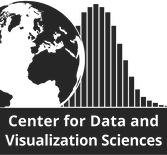What is GIS?
Geographic Information System (GIS) software allows you work with data that has a spatial (locational) component. When data layers are spatially enabled, the software can overlay them to create maps and to analyze spatial relationships. The user can choose how to symbolize features in the layers.
How?
Traditionally, you need software such as ArcGIS or QGIS for complex data analysis tasks or customized visual output. While that’s still true to some extent, many cloud based mapping products exist for creating thematic maps and spatial analysis, visualization software such as Tableau can create maps, and geospatial packages are available for statistical software such as R.
GIS consultants in the Center for Data and Visualization Sciences can advise you on the best approaches for locating geospatial data, creating maps, and analyzing your spatial data. The CDVS sponsors workshops on using digital mapping software and map design.
GIS in the Library
The Brandaleone Lab for Data and Visualization Services is located in the Edge on the first floor of Bostock. Installed mapping software includes:
GIS at Duke
- The Geospatial Analysis Certificate Program in Duke's Nicholas School of the Environment offers a number of geospatial analysis courses.
- The Duke Digital Art History & Visual Culture Research Lab has courses on Historical GIS and related digitial humanities visualization topics.
Help?
Contact us at askdata@duke.edu

